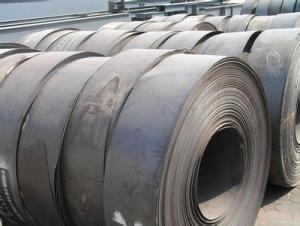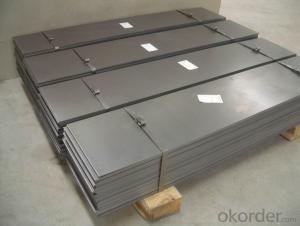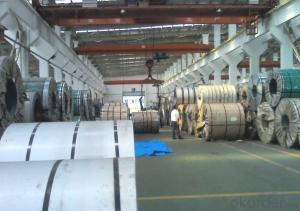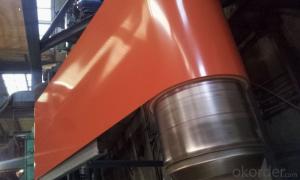hot rolled steel strip
- Loading Port:
- China Main Port
- Payment Terms:
- TT OR LC
- Min Order Qty:
- -
- Supply Capability:
- -
OKorder Service Pledge
OKorder Financial Service
You Might Also Like
Product Description:
Spring Steel:
Spring steel is divided into two types, one is alloy spring steel, and other one is carbon spring steel.
Alloy spring steel is a type that is used for manufacturing springs and other elastic parts. Spring steel should have high ratio of yield strength and tensile strength and elastic limit to make sure that the springs obtain enough power of elastic deformation and can bear much load.
Types of alloy spring steel: Si-Mn spring steel, Si-Cr spring steel, Cr-Mn Spring steel, Cr-V spring steel and so on.
Specification of Spring Strip Steel:
-Material: 30W4Cr2VA
-Standard: GB/T 1222-2007
-Type: Spring Steel
Chemical Composition:
C | Si | Mn | S |
0.26~0.34 | 0.17~0.37 | ≤0.40 | ≤0.030 |
P | Cr | Ni | Cu |
≤0.030 | 2.00~2.50 | ≤0.35 | ≤0.25 |
V | W | | |
0.50~0.80 | 4.00~4.50 | | |
Mechanical Properties:
-Yield Strength σs (MPa): ≥1470 (150)
-Elongation δ10(%):≥7
-Hardness:
1, Hot rolled + Heat treatment, ≤321HB
2, Cold drawn + Heat treatment: ≤321HB
-Impact Power: ≥40
Norm of heat treatment:
1, Quenching: 1050℃~1100℃.
2, Cooled by oil.
3, Tempering: 600℃±50℃.
Usage/Applications of Spring Strip Steel:
-Due to the elements W, Cr and V, this type of spring steel obtain pretty high hardenability and nice mechanical properties under room temperature and high temperature. The tempering stability and hot workability are good.
-Being used under the state of quenching and high temperature tempering. It’s usually used as heat-resisting springs with working temperature below 500℃, like main secure valve spring of furnace and turbine steam seal leaf springs.
Packaging & Delivery of Spring Strip Steel:
-Packing Detail: The products will be well packed.
-Marks: there are two types of marks.
1, Tag marks. To show customers the specifications of products, company name and logo and other information required by customers.
2, Color marks. It’s easy for customers to distinguish them from other products at destination port.
-Delivery Detail: 30~45 working days after receive buyer’s T.T. or L/C.
Transportation:
1, The products can be delivered by bulk vessel or by container.
2, The maximum quantity of loading of container is 25 tons.
3, The products usually are transported to the nearest port from the production place.
Payment:
-Theoretical weight/Actual weight.
-FOB, CFR or CIF.
-Terms of payment: T.T. or L/C at sight.
Photos of Spring Strip Steel:
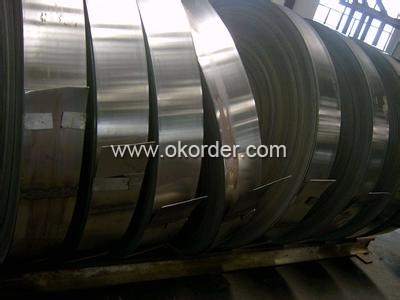
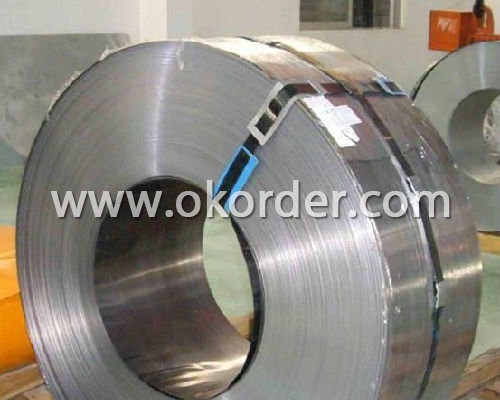
- Q:What are the common defects found in steel strips?
- Some common defects found in steel strips include surface defects like scratches, pits, and scale, as well as internal defects such as cracks, voids, and segregation. Other common defects may include edge deformation, wavy edges, and thickness variations.
- Q:What are the different types of corrosion protection for steel strips?
- There are several types of corrosion protection methods that can be used for steel strips. Some of the most common ones include: 1. Galvanization: This process involves coating the steel strip with a layer of zinc. The zinc acts as a sacrificial anode, corroding before the steel does. This method provides excellent protection against corrosion and is commonly used for outdoor applications. 2. Powder coating: This method involves applying a layer of powdered polymer onto the steel strip, which is then heated and cured to form a protective coating. Powder coating is highly resistant to corrosion, abrasion, and chemicals, making it a popular choice for various industries. 3. Paint coatings: Painting the steel strip with a corrosion-resistant paint is another effective method of protection. The paint creates a barrier between the steel and the environment, preventing moisture and oxygen from reaching the metal surface. 4. VCI (Vapor Corrosion Inhibitor): VCI technology involves vaporizing a corrosion inhibitor and sealing it within a package or enclosure containing the steel strips. The inhibitor molecules form a protective layer on the metal surface, preventing corrosion. 5. Hot-dip aluminizing: This process involves immersing the steel strip in a bath of molten aluminum. The aluminum forms a protective layer on the surface of the steel, providing corrosion resistance. 6. Electroplating: Electroplating involves immersing the steel strip in an electrolyte solution and passing an electric current through it. This causes a layer of metal (e.g., zinc, nickel, or chromium) to be deposited onto the steel, providing corrosion protection. 7. Organic coatings: Organic coatings, such as epoxy or polyurethane paints, can be applied to steel strips to provide corrosion protection. These coatings offer excellent resistance to moisture, chemicals, and UV radiation. It is important to consider the specific application and environment in order to choose the most suitable method of corrosion protection for steel strips. Each method has its own advantages and limitations, so it is essential to evaluate factors such as durability, cost-effectiveness, and maintenance requirements before making a decision.
- Q:How are steel strips used in the furniture industry?
- Steel strips are commonly used in the furniture industry for various purposes such as reinforcement, support, and structural stability. They are often used as framing materials for chairs, tables, and other furniture pieces, providing strength and durability to the overall structure. Additionally, steel strips can be used to create decorative elements or accents, adding a modern and industrial touch to furniture designs.
- Q:What are the properties of high-strength steel strips?
- High-strength steel strips possess excellent mechanical properties, including high tensile strength, good toughness, and high fatigue resistance. They also exhibit good formability, enabling them to be easily shaped and fabricated. Additionally, high-strength steel strips have improved corrosion resistance and can withstand extreme temperatures, making them suitable for various demanding applications in industries such as automotive, aerospace, and construction.
- Q:How do steel strips perform in frictional applications?
- Steel strips perform exceptionally well in frictional applications. Due to their high strength and durability, they can withstand heavy loads and resist wear and tear over time. Their smooth surface and low coefficient of friction ensure efficient and consistent performance, making them ideal for applications such as braking systems, clutch plates, and conveyor belts. Additionally, steel strips are known for their excellent heat dissipation properties, which helps to minimize overheating and maintain optimal performance even under intense frictional conditions.
- Q:What are the challenges faced in the production of steel strips?
- The production of steel strips presents several challenges that need to be addressed. One major challenge revolves around the high energy consumption during the manufacturing process. The production of steel demands a significant amount of energy, encompassing both electricity and fuel. This poses not only a cost challenge but also an obstacle to environmental sustainability. Another obstacle lies in ensuring the quality control of the steel strips. It is crucial to maintain consistent and uniform thickness, width, and surface quality in order to produce high-quality steel strips. Any variation in these parameters can result in defects and inconsistencies in the final product. Achieving the desired mechanical properties of the steel strips also proves to be a challenge. The production process involves various heat treatments and mechanical processing, all of which must be meticulously controlled to attain the desired strength, hardness, and ductility of the steel. Deviating from the required properties can render the steel strips unsuitable for their intended applications. Moreover, the production of steel strips often involves the handling and processing of large and heavy coils. This logistical challenge necessitates specialized equipment and infrastructure to efficiently transport, store, and handle the steel strips. Lastly, the steel industry confronts the challenge of increasing competition and market demand. In order to remain competitive, steel manufacturers must continually enhance their production processes, reduce costs, and adapt to the changing demands of customers. This entails investing in research and development, as well as embracing new technologies and market trends. In conclusion, the production of steel strips is a complex process that requires overcoming challenges related to energy consumption, quality control, mechanical properties, logistics, and market demands. Nevertheless, through continuous innovation and improvement, these challenges can be tackled, resulting in the production of high-quality steel strips that fulfill the requirements of various industries.
- Q:How do steel strips contribute to sustainable manufacturing practices?
- Steel strips contribute to sustainable manufacturing practices in several ways. Firstly, steel is a highly recyclable material, meaning that steel strips can be recycled and reused multiple times without losing their properties. This reduces the need for new steel production, conserves natural resources, and minimizes environmental impacts associated with mining and extraction. Additionally, steel strips are durable and have a long lifespan, making them suitable for various applications and reducing the need for frequent replacements. This saves energy and resources. Furthermore, steel strips can be manufactured using energy-efficient processes, such as electric arc furnaces, which emit fewer greenhouse gases compared to traditional steelmaking methods. Overall, the use of steel strips promotes circular economy principles, reduces waste generation, and contributes to a more sustainable manufacturing industry.
- Q:What are the common edge burr tolerances for steel strips?
- The tolerance levels for edge burrs in steel strips can differ depending on the unique demands of the application and the manufacturing process employed. Generally, the industry norm for edge burr tolerances in steel strips typically ranges from ±0.005 inches to ±0.010 inches. These tolerances guarantee that the edges of the steel strips are free from excessive burrs or sharp edges, which could potentially cause issues during subsequent processing or end-use applications. It is important to acknowledge that the specific tolerances may fluctuate based on factors such as the thickness of the steel strip, the type of steel utilized, and the manufacturing technique employed. Hence, it is crucial to refer to the applicable industry standards or the specific requirements outlined by the customer or end-user to obtain precise edge burr tolerances in steel strips.
- Q:Are steel strips resistant to UV radiation?
- No, steel strips are not resistant to UV radiation.
- Q:Are steel strips used in the production of automotive body panels?
- Steel strips are commonly employed in the manufacturing of automotive body panels. The automotive industry extensively utilizes steel due to its robustness, longevity, and cost-effectiveness. Essentially, steel strips are utilized to construct the fundamental framework of various body panels, such as the roof, doors, fenders, and hood. These strips are frequently shaped and fused together to achieve the desired panel configuration. Furthermore, steel strips offer exceptional safeguarding against collisions and contribute to upholding the structural stability of the vehicle. Nevertheless, with the progression of technology, alternative materials like aluminum and carbon fiber are also finding their way into the fabrication of automotive body panels owing to their reduced weight and enhanced fuel efficiency.
1. Manufacturer Overview |
|
|---|---|
| Location | |
| Year Established | |
| Annual Output Value | |
| Main Markets | |
| Company Certifications | |
2. Manufacturer Certificates |
|
|---|---|
| a) Certification Name | |
| Range | |
| Reference | |
| Validity Period | |
3. Manufacturer Capability |
|
|---|---|
| a)Trade Capacity | |
| Nearest Port | |
| Export Percentage | |
| No.of Employees in Trade Department | |
| Language Spoken: | |
| b)Factory Information | |
| Factory Size: | |
| No. of Production Lines | |
| Contract Manufacturing | |
| Product Price Range | |
Send your message to us
hot rolled steel strip
- Loading Port:
- China Main Port
- Payment Terms:
- TT OR LC
- Min Order Qty:
- -
- Supply Capability:
- -
OKorder Service Pledge
OKorder Financial Service
Similar products
New products
Hot products
Hot Searches
Related keywords






















